Unit 4 Meeting the muse Using ideas课件(共39张PPT,内镶嵌视频和音频)-高中英语外研版(2019)选择性必修第一册
文档属性
| 名称 | Unit 4 Meeting the muse Using ideas课件(共39张PPT,内镶嵌视频和音频)-高中英语外研版(2019)选择性必修第一册 | 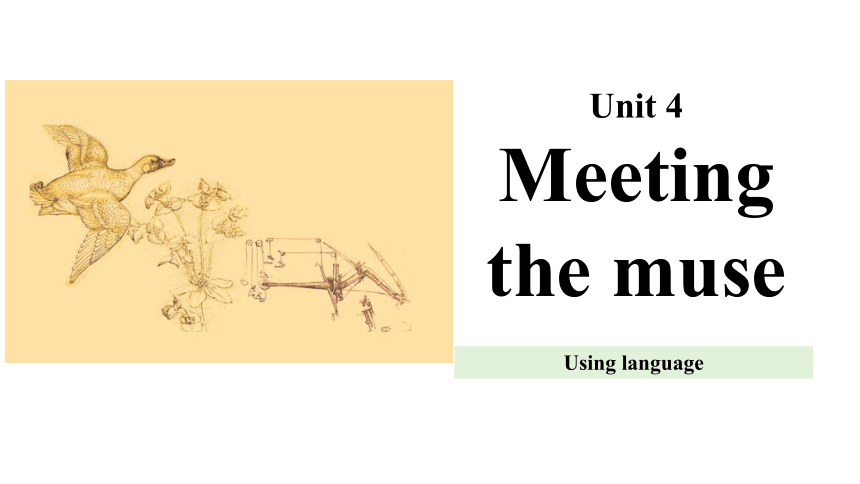 | |
| 格式 | pptx | ||
| 文件大小 | 61.4MB | ||
| 资源类型 | 教案 | ||
| 版本资源 | 外研版(2019) | ||
| 科目 | 英语 | ||
| 更新时间 | 2025-06-19 17:02:10 | ||
图片预览

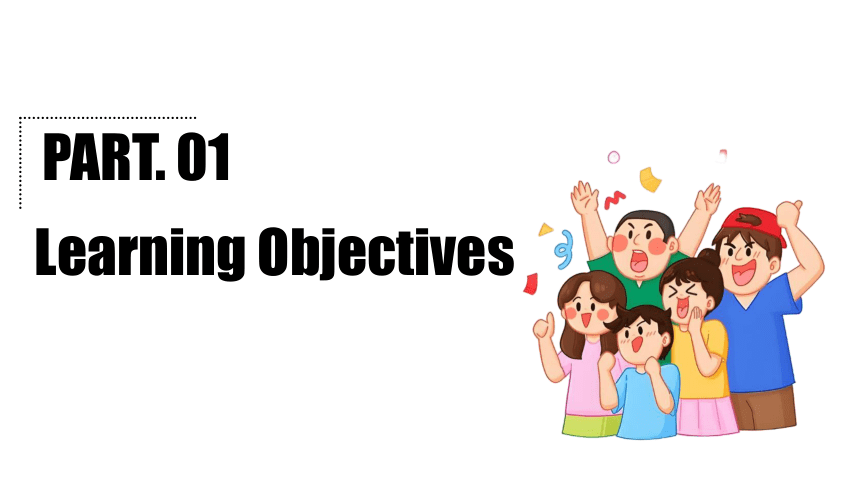

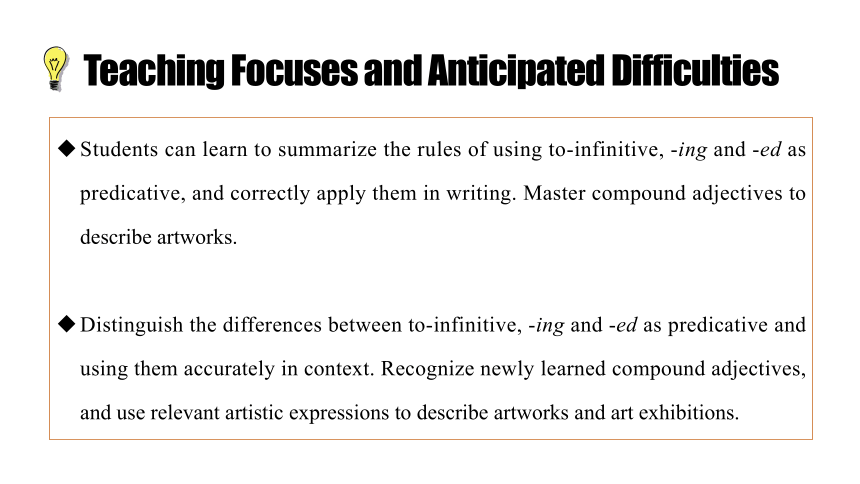
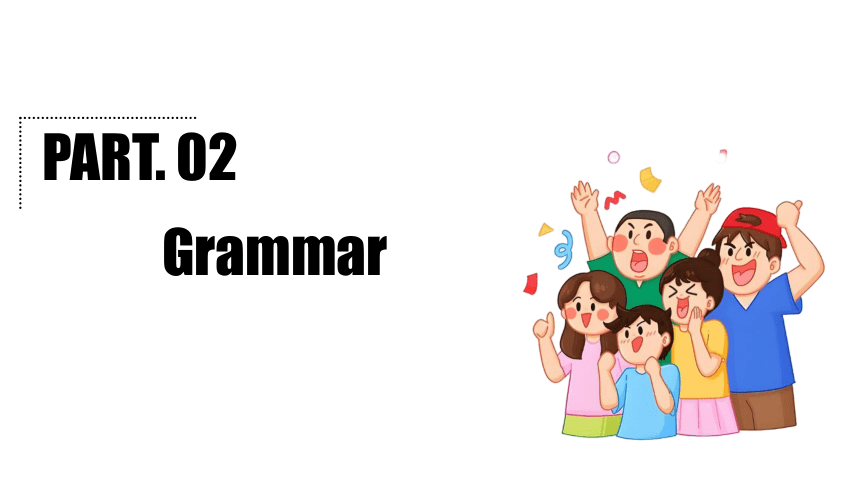
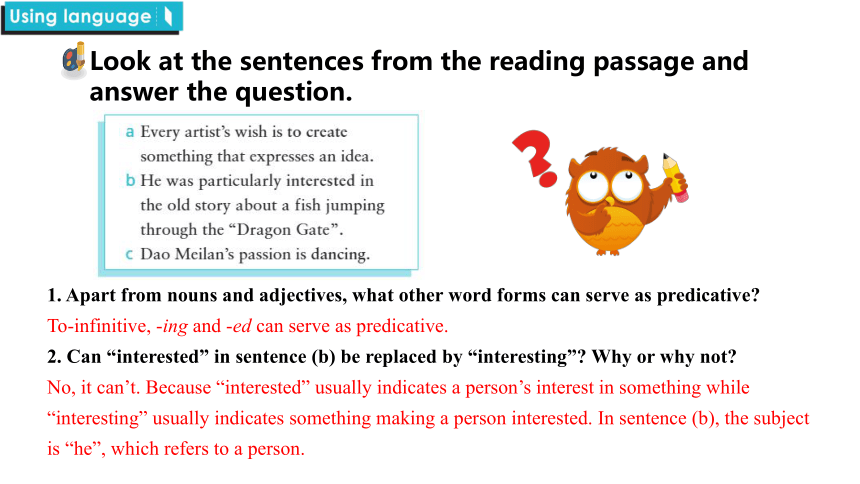
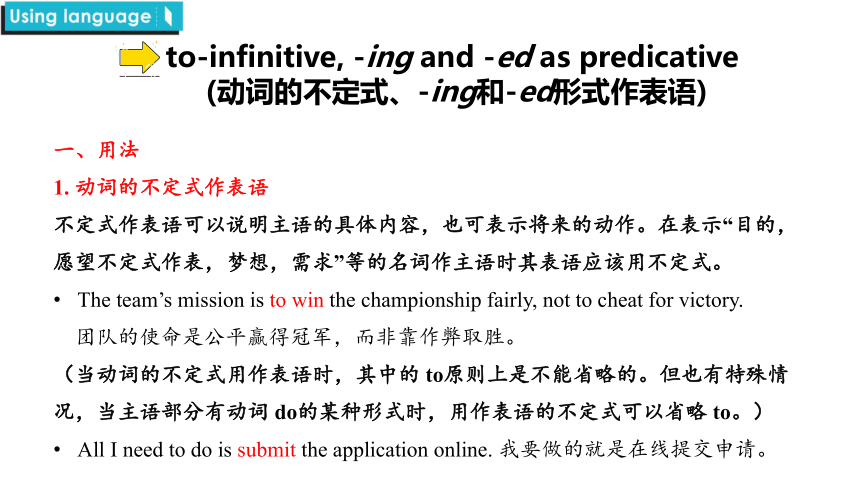
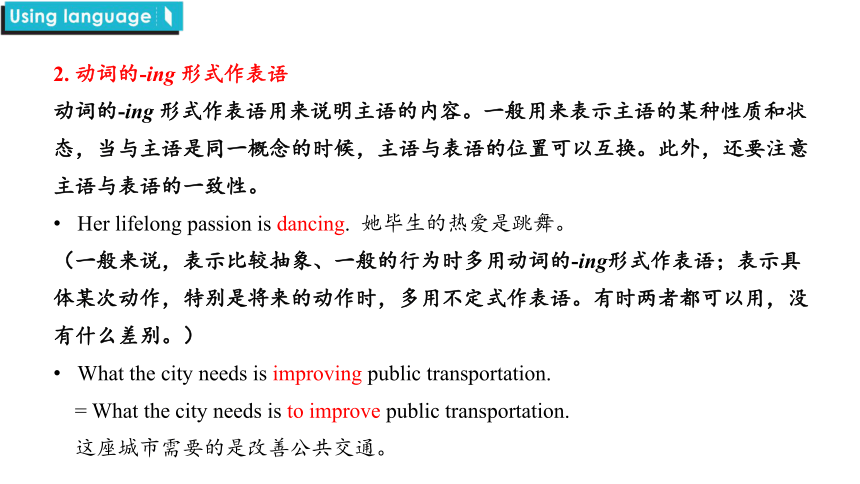
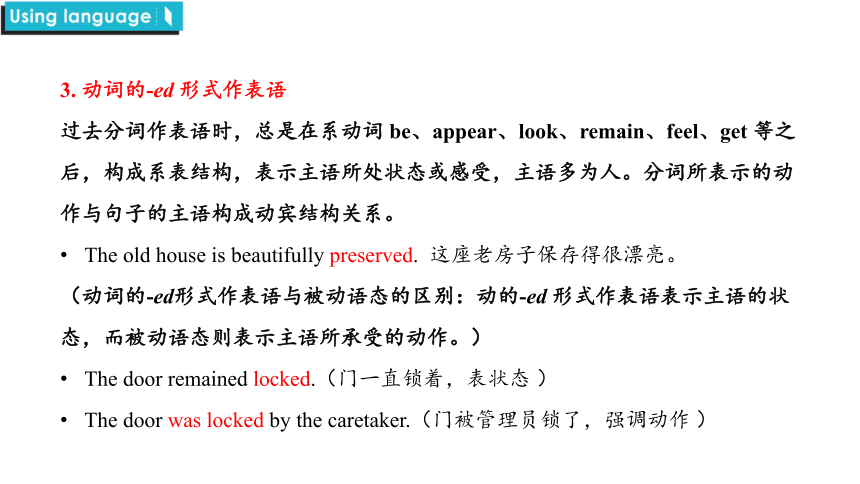
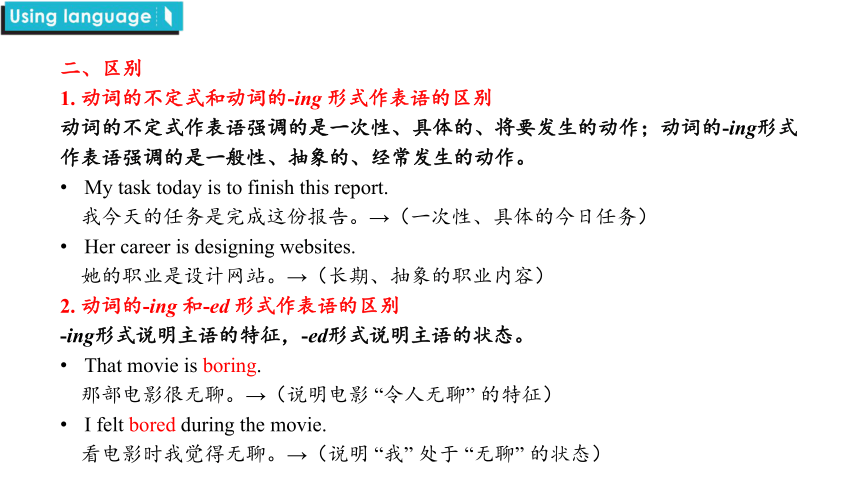
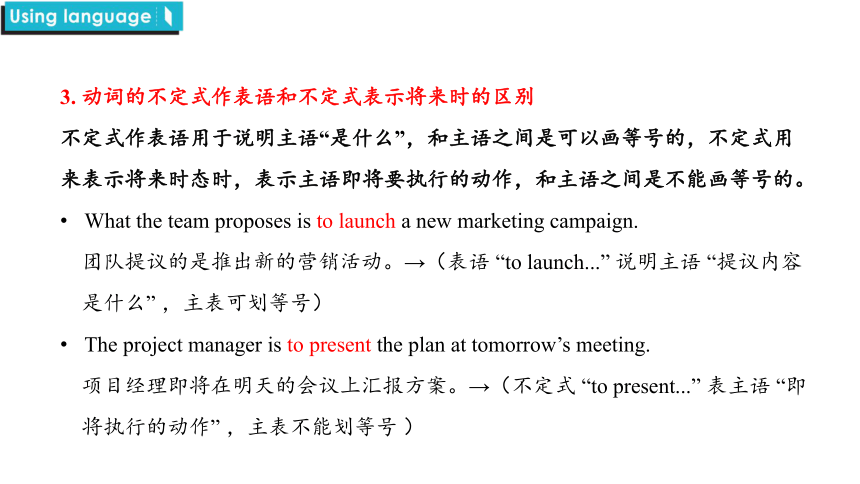
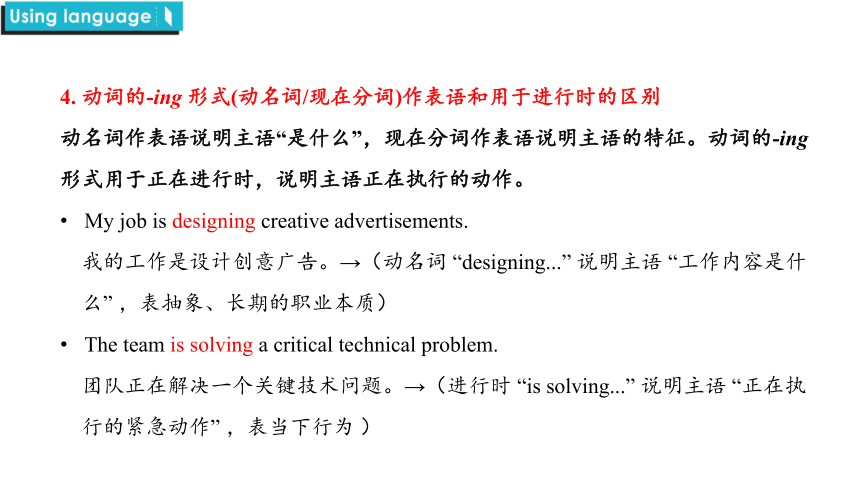
文档简介
(共39张PPT)
Using language
Unit 4
Meeting
the muse
Learning Objectives
PART. 01
Understand the daily study and life of British middle school students by watching videos. Based on your own daily study and life, compare the study and life in Chinese and British schools, and find out the similarities and differences between the two. Talk about your first impression of high school life, and have a preliminary perception of the study and life in the senior high school stage.
Learning Objectives
Observe example sentences, discover and summarize the rules of using to-infinitive, -ing and -ed as predicative, and correctly use it in writing, enhancing the precision and fluency of their written language. Master the knowledge of compound adjectives, recognize newly learned compound adjectives, and use relevant artistic expressions to describe artworks and art exhibitions.
Cultivate your awareness of art as a cultural carrier by appreciating artworks and understand the cultural connotations behind art exhibitions.
Develop the inductive thinking through observing and summarizing rules of using to-infinitive, -ing and -ed as predicative, and enhance the analytical ability to deconstruct sentence structures.
Adopt effective learning strategies, such as discovering grammatical rules through observation and practicing with examples, to improve their independent learning ability.
Understand the daily study and life of British middle school students by watching videos. Based on your own daily study and life, compare the study and life in Chinese and British schools, and find out the similarities and differences between the two. Talk about your first impression of high school life, and have a preliminary perception of the study and life in the senior high school stage.
Teaching Focuses and Anticipated Difficulties
Students can learn to summarize the rules of using to-infinitive, -ing and -ed as predicative, and correctly apply them in writing. Master compound adjectives to describe artworks.
Distinguish the differences between to-infinitive, -ing and -ed as predicative and using them accurately in context. Recognize newly learned compound adjectives, and use relevant artistic expressions to describe artworks and art exhibitions.
Grammar
PART. 02
Look at the sentences from the reading passage and answer the question.
1. Apart from nouns and adjectives, what other word forms can serve as predicative
To-infinitive, -ing and -ed can serve as predicative.
2. Can “interested” in sentence (b) be replaced by “interesting” Why or why not
No, it can’t. Because “interested” usually indicates a person’s interest in something while “interesting” usually indicates something making a person interested. In sentence (b), the subject is “he”, which refers to a person.
to-infinitive, -ing and -ed as predicative
(动词的不定式、-ing和-ed形式作表语)
一、用法
1. 动词的不定式作表语
不定式作表语可以说明主语的具体内容,也可表示将来的动作。在表示“目的,愿望不定式作表,梦想,需求”等的名词作主语时其表语应该用不定式。
The team’s mission is to win the championship fairly, not to cheat for victory.
团队的使命是公平赢得冠军,而非靠作弊取胜。
(当动词的不定式用作表语时,其中的 to原则上是不能省略的。但也有特殊情况,当主语部分有动词 do的某种形式时,用作表语的不定式可以省略 to。)
All I need to do is submit the application online. 我要做的就是在线提交申请。
2. 动词的-ing 形式作表语
动词的-ing 形式作表语用来说明主语的内容。一般用来表示主语的某种性质和状态,当与主语是同一概念的时候,主语与表语的位置可以互换。此外,还要注意主语与表语的一致性。
Her lifelong passion is dancing. 她毕生的热爱是跳舞。
(一般来说,表示比较抽象、一般的行为时多用动词的-ing形式作表语;表示具体某次动作,特别是将来的动作时,多用不定式作表语。有时两者都可以用,没有什么差别。)
What the city needs is improving public transportation.
= What the city needs is to improve public transportation.
这座城市需要的是改善公共交通。
3. 动词的-ed 形式作表语
过去分词作表语时,总是在系动词 be、appear、look、remain、feel、get 等之后,构成系表结构,表示主语所处状态或感受,主语多为人。分词所表示的动作与句子的主语构成动宾结构关系。
The old house is beautifully preserved. 这座老房子保存得很漂亮。
(动词的-ed形式作表语与被动语态的区别:动的-ed 形式作表语表示主语的状态,而被动语态则表示主语所承受的动作。)
The door remained locked.(门一直锁着,表状态 )
The door was locked by the caretaker.(门被管理员锁了,强调动作 )
二、区别
1. 动词的不定式和动词的-ing 形式作表语的区别
动词的不定式作表语强调的是一次性、具体的、将要发生的动作;动词的-ing形式作表语强调的是一般性、抽象的、经常发生的动作。
My task today is to finish this report.
我今天的任务是完成这份报告。→(一次性、具体的今日任务)
Her career is designing websites.
她的职业是设计网站。→(长期、抽象的职业内容)
2. 动词的-ing 和-ed 形式作表语的区别
-ing形式说明主语的特征,-ed形式说明主语的状态。
That movie is boring.
那部电影很无聊。→(说明电影 “令人无聊” 的特征)
I felt bored during the movie.
看电影时我觉得无聊。→(说明 “我” 处于 “无聊” 的状态)
3. 动词的不定式作表语和不定式表示将来时的区别
不定式作表语用于说明主语“是什么”,和主语之间是可以画等号的,不定式用来表示将来时态时,表示主语即将要执行的动作,和主语之间是不能画等号的。
What the team proposes is to launch a new marketing campaign.
团队提议的是推出新的营销活动。→(表语 “to launch...” 说明主语 “提议内容
是什么” ,主表可划等号)
The project manager is to present the plan at tomorrow’s meeting.
项目经理即将在明天的会议上汇报方案。→(不定式 “to present...” 表主语 “即
将执行的动作” ,主表不能划等号 )
4. 动词的-ing 形式(动名词/现在分词)作表语和用于进行时的区别
动名词作表语说明主语“是什么”,现在分词作表语说明主语的特征。动词的-ing形式用于正在进行时,说明主语正在执行的动作。
My job is designing creative advertisements.
我的工作是设计创意广告。→(动名词 “designing...” 说明主语 “工作内容是什
么” ,表抽象、长期的职业本质)
The team is solving a critical technical problem.
团队正在解决一个关键技术问题。→(进行时 “is solving...” 说明主语 “正在执
行的紧急动作” ,表当下行为 )
5. 动词的-ed 形式作表语和用于被动语态的区别
动词的-ed 形式作表语说明主语所处的状态。用于被动语态说明主语所承受的动作。
She was delighted by the surprise party.
她因惊喜派对而感到开心。→ -ed 形式 “delighted” 说明主语 “她” 所处的情感状态 —— 开心)
He was praised by the teacher for his hard work.
他因努力学习被老师表扬了。→ -ed 形式 “praised” 用于被动语态,说明主语 “他” 承受的动作 —— 被表扬)
Read the passage and underline the predicatives.
One of my biggest dreams had always been to see the painting Girl with a Pearl Earring, by the Dutch artist, Vermeer. It wasn’t until we went on a trip to The Hague last year that this dream came true! There were lots of people waiting to enter the Mauritshuis. Although my legs were tired from walking around the city, I was determined to see the painting, which is often called the “Mona Lisa of the North”. Nobody is sure of the identity of the girl in it. And there she was. It was amazing to be standing in front of her at last! The girl is looking over her shoulder. Her eyes are wide and her mouth is parted, just as if she were about to
speak. I would love to know what she was going to say!
Complete the passage with correct form of the words in the box.
Chinese artist Wu Guanzhong is 1____________ (know) for his paintings using oils and also for those using the more traditional Chinese method of ink. According to Wu Guanzhong, his goal as an artist was 2____________ (combine) Western principles of art with Chinese spirit, and his passion is 3____________ (seek) a point at which the two could meet. To him, the important value of an artwork was 4____________ (reflect) the art within the life of Chinese people, and 5____________ (express) love of and responsibility to his motherland. Wu Guanzhong remained 6____________ (interest) in exploring ways of expression, with his style changing and developing throughout his career. His life’s work is now 7____________ (inspire) artists not only in China but across the world.
known
to combine
to seek
to reflect
to express
interested
inspiring
Think of an artist you admire and talk about his or her inspiration and artworks using to-infinitive, -ing and -ed as predicative where appropriate.
Read the comments and answer the questions. Pay attention to the compound adjectives in bold.
英语中的复合形容词是由两个或两个以上的单词通过连字符连接构成的特殊形容词形式,主要用于前置修饰名词 ,其构成方式包含名词+形容词、形容词+现在分词、数词+名词等18种常见类型。
Read the comments and answer the questions. Pay attention to the compound adjectives in bold.
1. What is the exhibition about What artworks might you see in it
The exhibition is about abstract art. We can see Storm and Superhighway in it.
2. Which comment makes the greatest impression on you Give your reasons.
3. Do you want to go to this exhibition after reading the comments Why or why not
Match the compound adjectives in Activity 5 to their meanings. Think of other words and expressions that can express the same meanings.
Now work in groups and think of more compound adjectives to describe an art exhibition or an artwork.
_______________: extremely impressive so as to take one’s breath away
_______________: known by a lot of people
_______________: making you feel great respect and admiration, and sometimes fear
_______________: very good at doing something
_______________: innovative, using new methods or achieving new results
_______________: very expensive
breathtaking
well-known
awe-inspiring
highly-skilled
ground-breaking
over-priced
Listening
PART. 03
Have you ever visited an art exhibition
Read the passage and answer the questions.
Since the earliest cave paintings, humans have been exhibiting art on walls. There has always been a connection between artists and their works, their points of view, and the viewers. Bringing artworks together into an exhibition enables all of us to experience the works, to respond to, to enjoy and to connect with them.
Art exhibitions can have many themes, such as a historical period, a location or a trend. Of them all, one everlasting source of inspiration is war and peace. Countless artists have been protesting wars and promoting peace via their works, including Spanish artist Pablo Picasso and Chinese artist Feng Zikai, to name just a couple.
Read the passage and answer the questions.
1. What else do you know about Pablo Picasso and Feng Zikai
2. What other artists are famous for representing war and peace What are their best-known artworks
Appreciate the artworks.
Dora Maar au Chat
多拉·马尔与猫
Guernica
格尔尼卡
The Old Guitarist
老吉他手
Appreciate the artworks.
Listen to the audio guide and find out the main message of each artwork.
It is an optimistic message.
It shows temporary destruction of war and everlasting power of life, the strong spirit and hope, Feng Zikai’s encouragement to Chinese people as well as his hope for peace.
It is about the tragedy of war, the people's fear as well as Picasso’s anger towards the fighting.
Listen again and complete the notes.
Now work in pairs. Discuss which artwork makes the greater impression on you and why.
Guernica, by Pablo Picasso
Painted after 1_________________________ of Guernica
Size: 2______________________________________________
Images: a bull, a horse, a light bulb and a(n) 3____________________ lying on the ground
Using only three colours for 4__________________________
The Battlefield in Spring, by Feng Zikai
Painted 5________________ Japanese aggression against China
Images: sandbags, an army cap, a wire fence and 6____________________________
Contrast achieved with 7______________________________________
Showing Feng Zikai’s 8________________________________________________________
the attack on the town
3.5 metres in height and almost 8 metres in width
dead or wounded man
a more powerful effect
in protest of
some grass leaves
the lifeless objects and the grass leaves
encouragement to the Chinese people as well as his hope for peace
Complete the table with the expressions from the audio guide.
About an artwork Basic information What you see How you feel
by the well-known...;
It measures...;
It is widely believed...
In the centre of the painting, we can see...;
Through.., I can see…
Through..., I can feel...;
In my opinion, this makes...;
...create a strong contrast.;
I personally think...
Choose an art exhibition, or an artwork from an exhibition you like, and write about it using the words and expressions in this section.
Work in pairs.
Make improvements to each other’s writings and share them with the class.
Vocabulary
1. trend
a/the trend towards... 朝……的趋势
set the trend 开创潮流
follow the trend 追随趋势
on trend 流行的
例题:
Virtual reality (VR) classrooms are becoming _______ trend in education, offering immersive learning experiences for students.
on
Vocabulary
2. contrast
in contrast to/with 与……形成对比
by contrast 相比之下
contrast with 与……形成对比
contrast...with... 把……与……进行对比
例题:
Urban areas face air pollution issues, ______ contrast, rural regions struggle with water scarcity.
by
Exercise
PART. 04
1. The a________(抽象的) painting uses bold colors and shapes to express emotions rather than realistic scenes.
2. Teachers use i__________(创新的) methods like virtual reality to make complex scientific concepts more engaging for students.
3. The undersea c_______(电缆) connects Europe and North America, enabling high-speed data transmission across the Atlantic.
4. Electricians used insulated w______(电线) to replace the old circuit, ensuring safety and efficiency in the building’s power system.
bstract
Exercise: 单词拼写
nnovative
able
ires
The most important thing is ________ (finish) this project before the deadline.
Her greatest joy in life is ________ (travel) to remote cultures.
The result of the exam was ______________ (disappoint), but we’ll try harder.
My long-term goal is ____________ (become) a sustainable fashion designer.
The broken vase on the table looks ___________ (abandon).
One of his bad habits is always _____________ (complain) about small things.
After the accident, she felt ________ (shock) and couldn’t speak.
The team’s strategy for success is ____________ (innovate) constantly.
to finish
Exercise: 用所给词的适当形式填空
traveling
to become
disappointing
abandoned
complaining
shocked
innovating
Summary
PART. 05
Using language
Grammar
Vocabulary
Listening
动词的不定式、-ing和-ed形式作表语
用法
区别
Homework
PART. 06
Review what you have learnt in this class;
Think of more compound adjectives to describe an art exhibition or an artwork.
Homework
See you next class!
Using language
Unit 4
Meeting
the muse
Learning Objectives
PART. 01
Understand the daily study and life of British middle school students by watching videos. Based on your own daily study and life, compare the study and life in Chinese and British schools, and find out the similarities and differences between the two. Talk about your first impression of high school life, and have a preliminary perception of the study and life in the senior high school stage.
Learning Objectives
Observe example sentences, discover and summarize the rules of using to-infinitive, -ing and -ed as predicative, and correctly use it in writing, enhancing the precision and fluency of their written language. Master the knowledge of compound adjectives, recognize newly learned compound adjectives, and use relevant artistic expressions to describe artworks and art exhibitions.
Cultivate your awareness of art as a cultural carrier by appreciating artworks and understand the cultural connotations behind art exhibitions.
Develop the inductive thinking through observing and summarizing rules of using to-infinitive, -ing and -ed as predicative, and enhance the analytical ability to deconstruct sentence structures.
Adopt effective learning strategies, such as discovering grammatical rules through observation and practicing with examples, to improve their independent learning ability.
Understand the daily study and life of British middle school students by watching videos. Based on your own daily study and life, compare the study and life in Chinese and British schools, and find out the similarities and differences between the two. Talk about your first impression of high school life, and have a preliminary perception of the study and life in the senior high school stage.
Teaching Focuses and Anticipated Difficulties
Students can learn to summarize the rules of using to-infinitive, -ing and -ed as predicative, and correctly apply them in writing. Master compound adjectives to describe artworks.
Distinguish the differences between to-infinitive, -ing and -ed as predicative and using them accurately in context. Recognize newly learned compound adjectives, and use relevant artistic expressions to describe artworks and art exhibitions.
Grammar
PART. 02
Look at the sentences from the reading passage and answer the question.
1. Apart from nouns and adjectives, what other word forms can serve as predicative
To-infinitive, -ing and -ed can serve as predicative.
2. Can “interested” in sentence (b) be replaced by “interesting” Why or why not
No, it can’t. Because “interested” usually indicates a person’s interest in something while “interesting” usually indicates something making a person interested. In sentence (b), the subject is “he”, which refers to a person.
to-infinitive, -ing and -ed as predicative
(动词的不定式、-ing和-ed形式作表语)
一、用法
1. 动词的不定式作表语
不定式作表语可以说明主语的具体内容,也可表示将来的动作。在表示“目的,愿望不定式作表,梦想,需求”等的名词作主语时其表语应该用不定式。
The team’s mission is to win the championship fairly, not to cheat for victory.
团队的使命是公平赢得冠军,而非靠作弊取胜。
(当动词的不定式用作表语时,其中的 to原则上是不能省略的。但也有特殊情况,当主语部分有动词 do的某种形式时,用作表语的不定式可以省略 to。)
All I need to do is submit the application online. 我要做的就是在线提交申请。
2. 动词的-ing 形式作表语
动词的-ing 形式作表语用来说明主语的内容。一般用来表示主语的某种性质和状态,当与主语是同一概念的时候,主语与表语的位置可以互换。此外,还要注意主语与表语的一致性。
Her lifelong passion is dancing. 她毕生的热爱是跳舞。
(一般来说,表示比较抽象、一般的行为时多用动词的-ing形式作表语;表示具体某次动作,特别是将来的动作时,多用不定式作表语。有时两者都可以用,没有什么差别。)
What the city needs is improving public transportation.
= What the city needs is to improve public transportation.
这座城市需要的是改善公共交通。
3. 动词的-ed 形式作表语
过去分词作表语时,总是在系动词 be、appear、look、remain、feel、get 等之后,构成系表结构,表示主语所处状态或感受,主语多为人。分词所表示的动作与句子的主语构成动宾结构关系。
The old house is beautifully preserved. 这座老房子保存得很漂亮。
(动词的-ed形式作表语与被动语态的区别:动的-ed 形式作表语表示主语的状态,而被动语态则表示主语所承受的动作。)
The door remained locked.(门一直锁着,表状态 )
The door was locked by the caretaker.(门被管理员锁了,强调动作 )
二、区别
1. 动词的不定式和动词的-ing 形式作表语的区别
动词的不定式作表语强调的是一次性、具体的、将要发生的动作;动词的-ing形式作表语强调的是一般性、抽象的、经常发生的动作。
My task today is to finish this report.
我今天的任务是完成这份报告。→(一次性、具体的今日任务)
Her career is designing websites.
她的职业是设计网站。→(长期、抽象的职业内容)
2. 动词的-ing 和-ed 形式作表语的区别
-ing形式说明主语的特征,-ed形式说明主语的状态。
That movie is boring.
那部电影很无聊。→(说明电影 “令人无聊” 的特征)
I felt bored during the movie.
看电影时我觉得无聊。→(说明 “我” 处于 “无聊” 的状态)
3. 动词的不定式作表语和不定式表示将来时的区别
不定式作表语用于说明主语“是什么”,和主语之间是可以画等号的,不定式用来表示将来时态时,表示主语即将要执行的动作,和主语之间是不能画等号的。
What the team proposes is to launch a new marketing campaign.
团队提议的是推出新的营销活动。→(表语 “to launch...” 说明主语 “提议内容
是什么” ,主表可划等号)
The project manager is to present the plan at tomorrow’s meeting.
项目经理即将在明天的会议上汇报方案。→(不定式 “to present...” 表主语 “即
将执行的动作” ,主表不能划等号 )
4. 动词的-ing 形式(动名词/现在分词)作表语和用于进行时的区别
动名词作表语说明主语“是什么”,现在分词作表语说明主语的特征。动词的-ing形式用于正在进行时,说明主语正在执行的动作。
My job is designing creative advertisements.
我的工作是设计创意广告。→(动名词 “designing...” 说明主语 “工作内容是什
么” ,表抽象、长期的职业本质)
The team is solving a critical technical problem.
团队正在解决一个关键技术问题。→(进行时 “is solving...” 说明主语 “正在执
行的紧急动作” ,表当下行为 )
5. 动词的-ed 形式作表语和用于被动语态的区别
动词的-ed 形式作表语说明主语所处的状态。用于被动语态说明主语所承受的动作。
She was delighted by the surprise party.
她因惊喜派对而感到开心。→ -ed 形式 “delighted” 说明主语 “她” 所处的情感状态 —— 开心)
He was praised by the teacher for his hard work.
他因努力学习被老师表扬了。→ -ed 形式 “praised” 用于被动语态,说明主语 “他” 承受的动作 —— 被表扬)
Read the passage and underline the predicatives.
One of my biggest dreams had always been to see the painting Girl with a Pearl Earring, by the Dutch artist, Vermeer. It wasn’t until we went on a trip to The Hague last year that this dream came true! There were lots of people waiting to enter the Mauritshuis. Although my legs were tired from walking around the city, I was determined to see the painting, which is often called the “Mona Lisa of the North”. Nobody is sure of the identity of the girl in it. And there she was. It was amazing to be standing in front of her at last! The girl is looking over her shoulder. Her eyes are wide and her mouth is parted, just as if she were about to
speak. I would love to know what she was going to say!
Complete the passage with correct form of the words in the box.
Chinese artist Wu Guanzhong is 1____________ (know) for his paintings using oils and also for those using the more traditional Chinese method of ink. According to Wu Guanzhong, his goal as an artist was 2____________ (combine) Western principles of art with Chinese spirit, and his passion is 3____________ (seek) a point at which the two could meet. To him, the important value of an artwork was 4____________ (reflect) the art within the life of Chinese people, and 5____________ (express) love of and responsibility to his motherland. Wu Guanzhong remained 6____________ (interest) in exploring ways of expression, with his style changing and developing throughout his career. His life’s work is now 7____________ (inspire) artists not only in China but across the world.
known
to combine
to seek
to reflect
to express
interested
inspiring
Think of an artist you admire and talk about his or her inspiration and artworks using to-infinitive, -ing and -ed as predicative where appropriate.
Read the comments and answer the questions. Pay attention to the compound adjectives in bold.
英语中的复合形容词是由两个或两个以上的单词通过连字符连接构成的特殊形容词形式,主要用于前置修饰名词 ,其构成方式包含名词+形容词、形容词+现在分词、数词+名词等18种常见类型。
Read the comments and answer the questions. Pay attention to the compound adjectives in bold.
1. What is the exhibition about What artworks might you see in it
The exhibition is about abstract art. We can see Storm and Superhighway in it.
2. Which comment makes the greatest impression on you Give your reasons.
3. Do you want to go to this exhibition after reading the comments Why or why not
Match the compound adjectives in Activity 5 to their meanings. Think of other words and expressions that can express the same meanings.
Now work in groups and think of more compound adjectives to describe an art exhibition or an artwork.
_______________: extremely impressive so as to take one’s breath away
_______________: known by a lot of people
_______________: making you feel great respect and admiration, and sometimes fear
_______________: very good at doing something
_______________: innovative, using new methods or achieving new results
_______________: very expensive
breathtaking
well-known
awe-inspiring
highly-skilled
ground-breaking
over-priced
Listening
PART. 03
Have you ever visited an art exhibition
Read the passage and answer the questions.
Since the earliest cave paintings, humans have been exhibiting art on walls. There has always been a connection between artists and their works, their points of view, and the viewers. Bringing artworks together into an exhibition enables all of us to experience the works, to respond to, to enjoy and to connect with them.
Art exhibitions can have many themes, such as a historical period, a location or a trend. Of them all, one everlasting source of inspiration is war and peace. Countless artists have been protesting wars and promoting peace via their works, including Spanish artist Pablo Picasso and Chinese artist Feng Zikai, to name just a couple.
Read the passage and answer the questions.
1. What else do you know about Pablo Picasso and Feng Zikai
2. What other artists are famous for representing war and peace What are their best-known artworks
Appreciate the artworks.
Dora Maar au Chat
多拉·马尔与猫
Guernica
格尔尼卡
The Old Guitarist
老吉他手
Appreciate the artworks.
Listen to the audio guide and find out the main message of each artwork.
It is an optimistic message.
It shows temporary destruction of war and everlasting power of life, the strong spirit and hope, Feng Zikai’s encouragement to Chinese people as well as his hope for peace.
It is about the tragedy of war, the people's fear as well as Picasso’s anger towards the fighting.
Listen again and complete the notes.
Now work in pairs. Discuss which artwork makes the greater impression on you and why.
Guernica, by Pablo Picasso
Painted after 1_________________________ of Guernica
Size: 2______________________________________________
Images: a bull, a horse, a light bulb and a(n) 3____________________ lying on the ground
Using only three colours for 4__________________________
The Battlefield in Spring, by Feng Zikai
Painted 5________________ Japanese aggression against China
Images: sandbags, an army cap, a wire fence and 6____________________________
Contrast achieved with 7______________________________________
Showing Feng Zikai’s 8________________________________________________________
the attack on the town
3.5 metres in height and almost 8 metres in width
dead or wounded man
a more powerful effect
in protest of
some grass leaves
the lifeless objects and the grass leaves
encouragement to the Chinese people as well as his hope for peace
Complete the table with the expressions from the audio guide.
About an artwork Basic information What you see How you feel
by the well-known...;
It measures...;
It is widely believed...
In the centre of the painting, we can see...;
Through.., I can see…
Through..., I can feel...;
In my opinion, this makes...;
...create a strong contrast.;
I personally think...
Choose an art exhibition, or an artwork from an exhibition you like, and write about it using the words and expressions in this section.
Work in pairs.
Make improvements to each other’s writings and share them with the class.
Vocabulary
1. trend
a/the trend towards... 朝……的趋势
set the trend 开创潮流
follow the trend 追随趋势
on trend 流行的
例题:
Virtual reality (VR) classrooms are becoming _______ trend in education, offering immersive learning experiences for students.
on
Vocabulary
2. contrast
in contrast to/with 与……形成对比
by contrast 相比之下
contrast with 与……形成对比
contrast...with... 把……与……进行对比
例题:
Urban areas face air pollution issues, ______ contrast, rural regions struggle with water scarcity.
by
Exercise
PART. 04
1. The a________(抽象的) painting uses bold colors and shapes to express emotions rather than realistic scenes.
2. Teachers use i__________(创新的) methods like virtual reality to make complex scientific concepts more engaging for students.
3. The undersea c_______(电缆) connects Europe and North America, enabling high-speed data transmission across the Atlantic.
4. Electricians used insulated w______(电线) to replace the old circuit, ensuring safety and efficiency in the building’s power system.
bstract
Exercise: 单词拼写
nnovative
able
ires
The most important thing is ________ (finish) this project before the deadline.
Her greatest joy in life is ________ (travel) to remote cultures.
The result of the exam was ______________ (disappoint), but we’ll try harder.
My long-term goal is ____________ (become) a sustainable fashion designer.
The broken vase on the table looks ___________ (abandon).
One of his bad habits is always _____________ (complain) about small things.
After the accident, she felt ________ (shock) and couldn’t speak.
The team’s strategy for success is ____________ (innovate) constantly.
to finish
Exercise: 用所给词的适当形式填空
traveling
to become
disappointing
abandoned
complaining
shocked
innovating
Summary
PART. 05
Using language
Grammar
Vocabulary
Listening
动词的不定式、-ing和-ed形式作表语
用法
区别
Homework
PART. 06
Review what you have learnt in this class;
Think of more compound adjectives to describe an art exhibition or an artwork.
Homework
See you next class!
